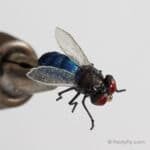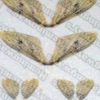Realistic Mayfly Wings – 2 Pairs – Front & Back Wings
Hemingway’s Realistic Mayfly Wings – 2 Pairs – Front & Back Wings are part of the famous Hemingway’s realistic wings collection. These mayfly wings here come as 2 pairs: 2 big wings for the front and 2 small back wings. The intricate detail on these is nothing less than amazing, mimicking the real fly so well and featuring life-like mayfly veins and a transparent and delicate appearance. Wings are shaped, sized, and colored – there is no need for any cutting, shaping, burning, coloring… Simply take them off the backing sheet and tie them on. In spite of their delicate look – these premium fly parts are very durable and will withstand many takes. They are premium quality, protected from the elements – waterproof and UV resistant, so no additional prep work is needed. They are made out of very flexible material so they are easy to bend and manipulate when tying. The softness and flexibility of the material make them easily gulped by the fish.
Flies made with these wings are meant to be used and used again. Many realistic flies are sitting at home and collecting dust. Now, it is time to get those realistic flies where they belong – on the water! Use them, lose them, no big deal, as they are affordable and easy to make.
With Hemingway’s Realistic Mayfly Wings you can make those wonderful realistic flies that fish just love to bite!
Hemingway’s Realistic Mayfly Wings – 2 Pairs – Front & Back Wings come in Small, Medium & Large, and a selection of four colors: Light Gray, Gray, Tan & Dark. Each package comes with 8 pairs of wings per pack to make 8 flies.
- Small – hooks sizes #14-#16
- Medium – hooks sizes #12-#14
- Large – hooks sizes #10-#12
Please note that due to many different types and models of hooks, these hook size recommendations are just rough estimates.
Tip: Due to their size, when peeling off Small wings, if you encounter any difficulty, use an Exacto knife along the edges of wing tabs to separate the tabs first and then peel off the wings from the sheet.
To make a great-looking, authentic mayfly pattern, pair them with Hemingway’s Mayfly Tube Bodies, or our Extended Mayfly Bodies.
These wings are also available as part of a set for tying realistic Ephemera Danica mayfly where they come in a pair with hyper-realistic mayfly bodies. Check them out here. A simpler version of these wings with just the big front wings you can find here.
Besides Mayfly wings in a variety of colors, we also offer Hemingway’s Realistic Wings for Caddis and Stonefly, also in a variety of colors and sizes. See them all here. Don’t forget to check out our Videos page for more interesting ideas and video fly tutorials and recipes.
Mayfly
Order: Ephemeroptera
Mayflies (also known as shadflies) belong to aquatic insects. They are primitive species, the oldest of winged insects, and can be dated back to the prehistoric ages. Mayflies go through incomplete metamorphosis, going from egg to nymph to adult, and lacking an intermediate pupal stage. Mayflies are also unique as being the only insect to have two winged adult life stages – the sexually immature – subimago and the reproductive, mature – imago.
Mayfly Dun Stage
When the exoskeleton of a mayfly nymph breaks open the adult mayfly gets released and emerges into an adult – a dun (subimago) with dull-colored wings and breathes air. They float on the water surface and wait for their wings to fill with fluid and their veins to harden (as opposed to the common presumption that they are drying their wings). During this time they are vulnerable and easily become prey to the hungry fish. Dun seeks shelter in the vegetation on the river banks. Mayfly duns live short lives before they transform again, most species only a couple of hours, but this can range anywhere from a few minutes to a couple of days. They are not such great fliers.
Mayfly dun has usually three long tails (some have two). Their forewings are large, lightly colored, and transparent, covered with veins and standing upright (similar to those of a butterfly). Some species have hindwings, however, these are small in size and have no function (they are vestigial). Their bodies are long and tapered with long, slim legs. Their size ranges from #4 to #24, with the most common size between #12 and #18.
The adult mayfly dun is sexually immature (unique in nature) and goes through another molt – from dun to a spinner (imago) – a mature mayfly ready to reproduce.
Fishing Mayfly Dun Patterns
The majority of mayfly species molt in the spring and early summer, while others do it at different times of the year. You could have sporadic hatches of certain species even in the late fall and early spring. These sporadic times could be even more interesting and productive for trout (and for a fisherman). During early spring and the fall, mayflies hatch in the warm hours of the day – usually midday. In the summertime, this event moves more towards the morning and late afternoon or early evenings. Usually, the warmer the weather, the shorter the hatch is – an hour or two. With cooler weather, this can last a couple of hours. As mayfly duns float on the surface like little sailboats, this behavior dictates the method of presentation of the fly that is imitating it. When presenting a dun imitation to the trout, it has to be drag-free and from upstream, not giving a fish much opportunity to see the line or leader. This can be done by cross-current reach cast. This way your fly will drift towards the trout before the line and the leader arrive.
To learn more about the mayfly life cycle and fly fishing techniques for different mayfly stages go here.
























Jerome Dwojak (verified owner) –
Very easy to work with in tying fles!